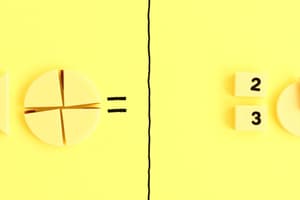Podcast
Questions and Answers
What is the first step in adding fractions with like denominators?
What is the first step in adding fractions with like denominators?
- Keep the denominator the same. (correct)
- Find the least common denominator.
- Add the numerators together.
- Simplify the fraction if possible.
In the equation $\frac{1}{4} + \frac{1}{6}$, what is the least common denominator (LCD)?
In the equation $\frac{1}{4} + \frac{1}{6}$, what is the least common denominator (LCD)?
- 10
- 6
- 12 (correct)
- 24
Which process is used to simplify the fraction $\frac{8}{12}$?
Which process is used to simplify the fraction $\frac{8}{12}$?
- Find the greatest common divisor (GCD) and divide both by it. (correct)
- Add the numerator to the denominator.
- Multiply both numerator and denominator by 2.
- Convert the fraction to a mixed number.
When adding the mixed numbers $2 \frac{1}{3}$ and $1 \frac{2}{5}$, what is the first step?
When adding the mixed numbers $2 \frac{1}{3}$ and $1 \frac{2}{5}$, what is the first step?
What is $\frac{5}{12}$ when added with $\frac{1}{3}$?
What is $\frac{5}{12}$ when added with $\frac{1}{3}$?
In a recipe, if you need $\frac{1}{4}$ cup of one ingredient and $\frac{1}{6}$ cup of another, what will your total amount of ingredients be?
In a recipe, if you need $\frac{1}{4}$ cup of one ingredient and $\frac{1}{6}$ cup of another, what will your total amount of ingredients be?
What is the simplified form of the fraction $\frac{10}{15}$?
What is the simplified form of the fraction $\frac{10}{15}$?
If you add $\frac{2}{7}$ and $\frac{3}{14}$, what do you get?
If you add $\frac{2}{7}$ and $\frac{3}{14}$, what do you get?
Flashcards are hidden until you start studying
Study Notes
Adding Fractions
Like Denominators
- Definition: Fractions that have the same denominator.
- Process:
- Keep the denominator the same.
- Add the numerators.
- Write the sum over the common denominator.
- Example:
- ( \frac{2}{5} + \frac{3}{5} = \frac{2 + 3}{5} = \frac{5}{5} = 1 )
Unlike Denominators
- Definition: Fractions that have different denominators.
- Process:
- Find the least common denominator (LCD).
- Convert each fraction to an equivalent fraction with the LCD.
- Add the numerators.
- Write the sum over the LCD.
- Example:
- ( \frac{1}{4} + \frac{1}{6} )
- LCD = 12
- Convert: ( \frac{3}{12} + \frac{2}{12} = \frac{5}{12} )
Simplifying Fractions
- Definition: Reducing a fraction to its lowest terms.
- Process:
- Find the greatest common divisor (GCD) of the numerator and denominator.
- Divide both by the GCD.
- Example:
- ( \frac{8}{12} )
- GCD = 4
- Simplified: ( \frac{8 \div 4}{12 \div 4} = \frac{2}{3} )
Mixed Numbers
- Definition: A whole number combined with a fraction.
- Addition Process:
- Convert mixed numbers to improper fractions.
- Follow the steps for adding fractions (like or unlike denominators).
- Convert back to a mixed number if necessary.
- Example:
- ( 2 \frac{1}{3} + 1 \frac{2}{5} )
- Convert: ( \frac{7}{3} + \frac{7}{5} )
- Find LCD (15): ( \frac{35}{15} + \frac{21}{15} = \frac{56}{15} = 3 \frac{11}{15} )
Word Problems
- Approach:
- Read the problem carefully and identify the fractions involved.
- Determine if the fractions have like or unlike denominators.
- Use the appropriate method to add the fractions.
- Simplify the result if needed and convert to a mixed number if applicable.
- Example:
- A recipe calls for ( \frac{1}{4} ) cup of sugar and ( \frac{1}{6} ) cup of brown sugar.
- Determine the total sugar:
- Find LCD (12):
- Convert: ( \frac{3}{12} + \frac{2}{12} = \frac{5}{12} ) cup of sugar.
Adding Fractions: Key Concepts
Like Denominators
- Fractions with the same denominator allow for straightforward addition.
- Keep the denominator constant, add the numerators, and place the result over the same denominator.
- Example: ( \frac{2}{5} + \frac{3}{5} = \frac{5}{5} = 1 ).
Unlike Denominators
- Fractions with different denominators require more steps for addition.
- Start by identifying the least common denominator (LCD).
- Convert each fraction using the LCD, then add the numerators, and place the result over the LCD.
- Example: For ( \frac{1}{4} + \frac{1}{6} ) with an LCD of 12, convert to ( \frac{3}{12} + \frac{2}{12} = \frac{5}{12} ).
Simplifying Fractions
- Simplifying fractions involves reducing them to their simplest form.
- Find the greatest common divisor (GCD) for the numerator and denominator.
- Divide both parts by the GCD to simplify.
- Example: ( \frac{8}{12} ) simplifies to ( \frac{2}{3} ) using a GCD of 4.
Mixed Numbers
- A mixed number combines a whole number with a fraction.
- To add mixed numbers, convert them into improper fractions first.
- Follow the addition process for fractions, then convert the resulting improper fraction back to a mixed number if needed.
- Example: Adding ( 2 \frac{1}{3} + 1 \frac{2}{5} ) involves converting to ( \frac{7}{3} + \frac{7}{5} ) and culminating in ( 3 \frac{11}{15} ).
Word Problems
- Solve word problems by carefully reading and identifying involved fractions.
- Determine if fractions have like or unlike denominators to apply the appropriate addition method.
- Simplify the resulting fraction and convert to a mixed number if required.
- Example: From a recipe requiring ( \frac{1}{4} ) cup of sugar and ( \frac{1}{6} ) cup of brown sugar, the total is ( \frac{5}{12} ) cups after conversion using the LCD of 12.
Studying That Suits You
Use AI to generate personalized quizzes and flashcards to suit your learning preferences.




